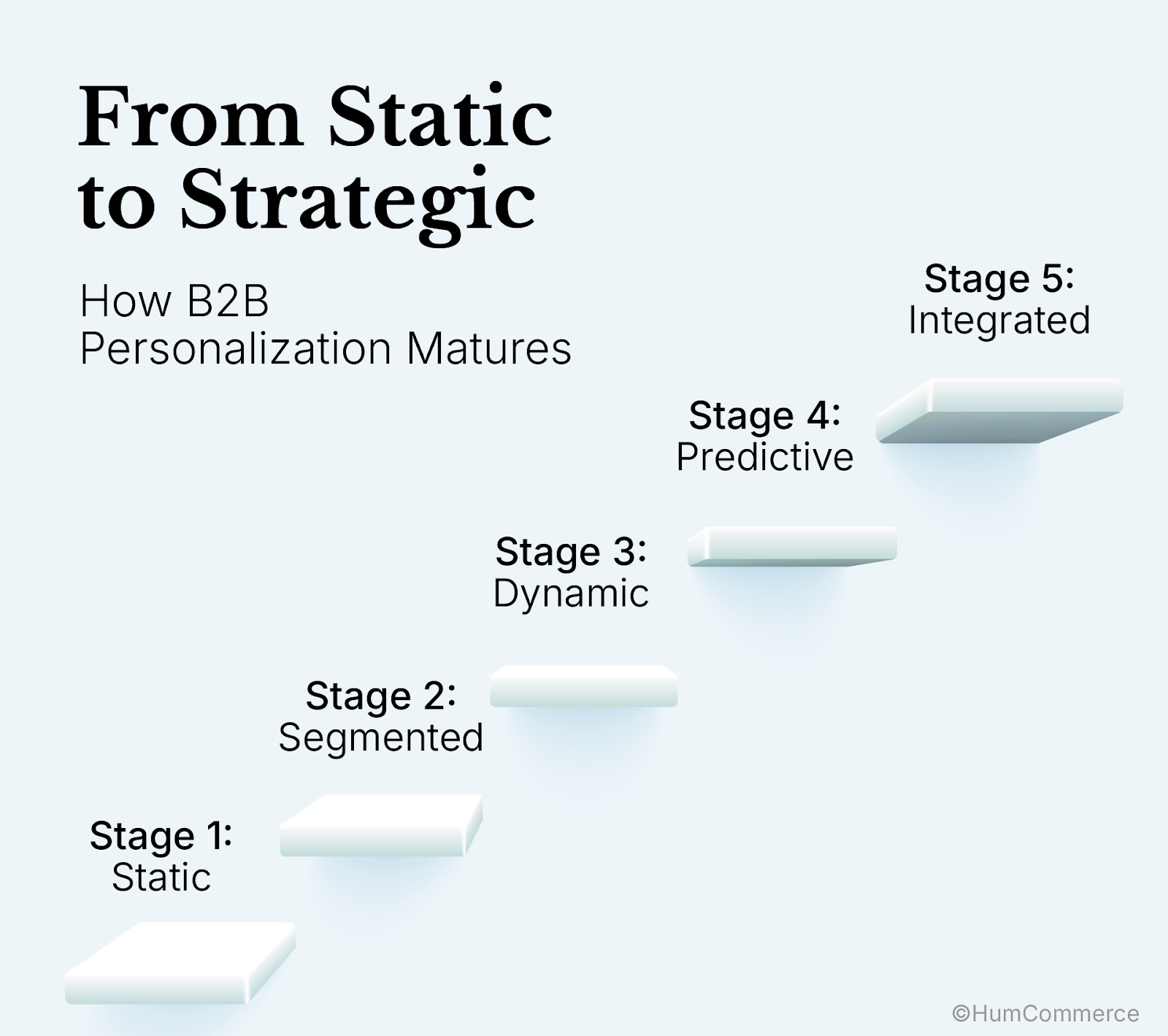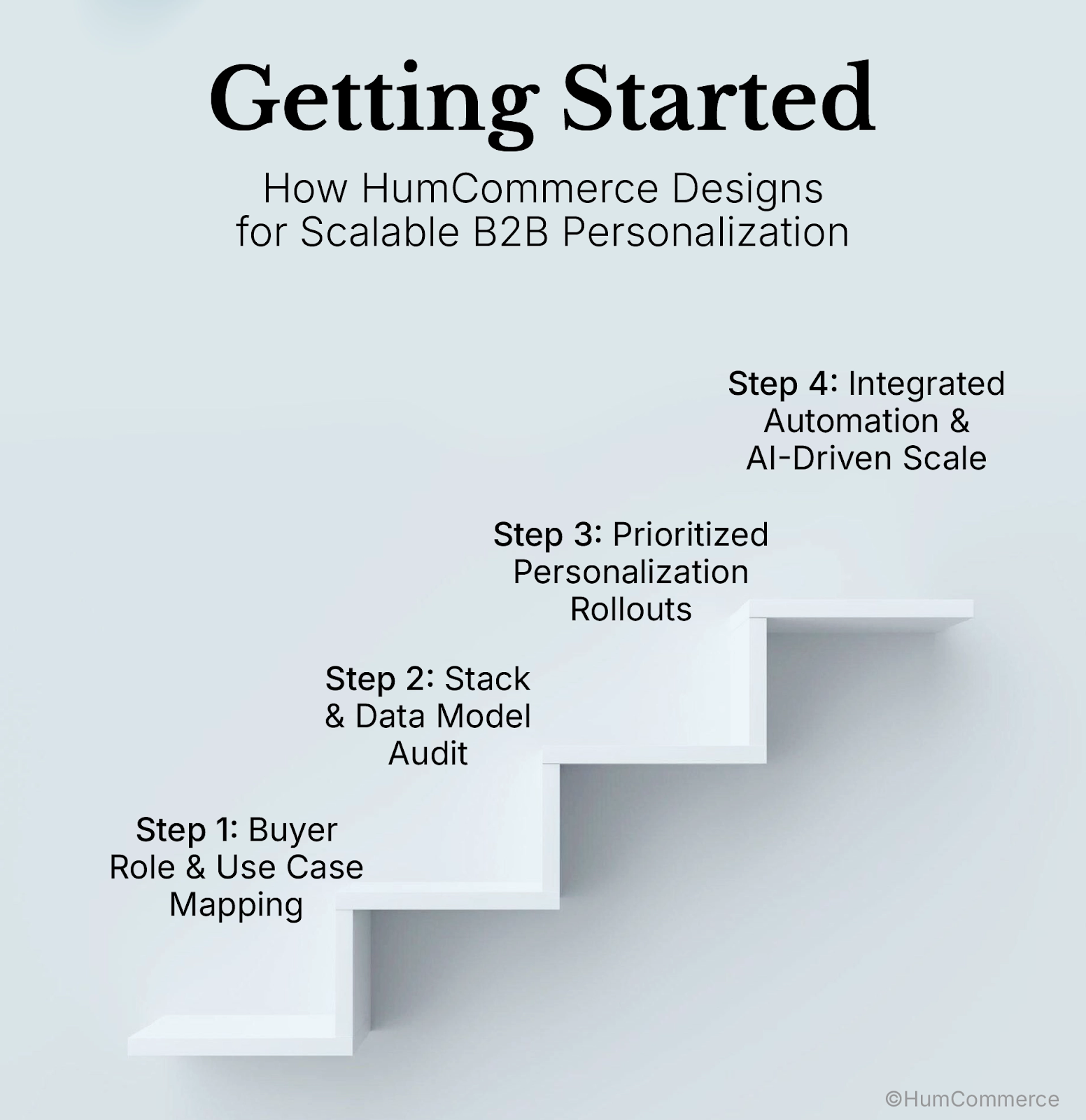Key Takeaways
- Most B2B storefronts still feel generic — and buyers notice
- Magento enables role-based catalogs, tiered pricing, and smart segmentation
- AI-driven recommendations increase repeat orders and AOV
- Dynamic content builds trust and reduces friction in the buying journey
- Personalization isn’t just UX — it’s revenue strategy
- B2B brands can scale relevance without added operational overhead
In B2C, personalization is table stakes.
In B2B, it’s still a competitive differentiator, but that’s changing fast.
At HumCommerce, we’ve seen firsthand how today’s B2B buyers behave more like digital consumers than ever before. They’re procurement professionals, technical specifiers, or finance approvers but they still expect tailored, efficient experiences that feel built for them.
And yet, most B2B storefronts still treat every buyer the same.
- Same catalog
- Same pricing
- Same clunky navigation, no matter the role, region, or lifecycle stage
That disconnect creates friction. It erodes trust. And in a landscape where switching suppliers is often just a few clicks away, it costs revenue.
This is where strategic personalization comes in as a way to scale relevance, improve conversions, and deepen buyer relationships.
But here’s the reality: personalization in B2B doesn’t mean showing the right product. It’s about structuring your systems so that each buyer feels seen at every stage of their journey.
That’s why at HumCommerce, we don’t treat personalization as a marketing trick.
We treat it as a growth capability — one that starts with your tech stack, but succeeds because of your strategy.
Why Most B2B Personalization Efforts Stall (And How to Spot It Early)
It’s Not the Vision That Fails. It’s the Execution Model
When we first speak with B2B teams about personalization, they usually know what they want:
- More relevance for their buyers
- More automation for their sales teams
- Smarter product discovery and fewer support tickets
But when we dig into what’s actually been implemented?
It’s often fragmented, underutilized, or misaligned.
Here’s what we’ve learned at HumCommerce:
Personalization doesn’t fail because people don’t understand its value.
It fails because the business isn’t structured to deliver it.
Misaligned Ownership: Who Actually Owns “Personalization”?
- Marketing sees it as messaging and segmentation
- Sales sees it as account management or quoting
- IT sees it as a customization risk
- Ops sees it as extra process
Ultimately, no one owns it end-to-end.
Without a clear owner, personalization becomes a “nice-to-have” that never gets prioritized — or worse, it becomes everyone’s responsibility and no one’s accountability.
Platform-Led, Not Strategy-Led
Many businesses start with tools:
“We just need to turn on Magento product recommendations,” or
“Our ERP has a personalization module — let’s try that.”
The result?
Point solutions without a connected data model. Manual personalization rules that don’t scale. Buyer experiences that feel inconsistent across channels.
Personalization without strategy turns into noise, not value.
Internal Complexity Hides Buyer Simplicity
B2B businesses have complex internal logic:
- Contract-specific pricing
- Multi-role approval chains
- Custom SKUs per region or division
That’s expected. But when this complexity leaks into the storefront, it creates friction instead of clarity.
Buyers don’t need to see how complex your systems are.
They need to see what’s relevant to them — nothing more, nothing less.
Sales Teams Bypass the System
Sales teams are often the most personalized asset a business has — they know the buyer, the pricing terms, and the nuances.
But when your storefront doesn’t reflect those realities, they stop trusting it.
- They email quotes manually
- They override product availability
- They ask IT for “just one exception”
The longer personalization lives outside your digital experience, the harder it is to scale. And eventually, it bottlenecks growth.
Systems Aren’t Talking, Or Aren’t Speaking the Same Language
Even when platforms like Magento, ERP, and CRM are in place, they often don’t sync cleanly.
- Pricing logic lives in ERP
- Product data sits in a PIM
- Buyer segmentation is managed in marketing automation tools
- And the storefront is left trying to stitch together a unified experience from fragmented sources
This is a strategic issue, one that HumCommerce solves by designing connected personalization architectures, not isolated features.
The B2B eCommerce Personalization Strategy Model
From Static to Strategic — How B2B Personalization Matures
We often walk into B2B environments where the intent to personalize is clear — but the execution is stuck. That’s why we created a framework to help businesses benchmark where they stand today and where they can realistically go next.
We call it the B2B Personalization Maturity Model.

It’s the path most B2B companies follow as they move from “one-size-fits-all” stores to experiences that feel tailor-made for every buyer.
The goal?
To help leadership teams focus on the right moves — not just cosmetic upgrades, but changes that actually drive revenue, loyalty, and growth.
Here is how the journey looks like…
Stage 1: Static
“There’s no unique experience”
Your top customer and a random visitor see the same thing. Same catalog, same prices, no context.
No context. No recognition.
The issue is there’s no personal connection. The site doesn’t feel like a buying tool. There’s a lot of load on the sales team.
Business Impact: There’s low engagement, inconsistency in conversions and there’s a lot of dependency on manual sales effort.
Stage 2: Segmented
“Starting to speak your buyers’ languages.”
You start grouping buyers based on who they are — wholesalers versus dealers, domestic versus international.
Custom catalogs, basic pricing tiers, and different product views come into play.
It’s still not perfect. Your systems may not talk to each other fully yet.
But you’re not treating every buyer like a stranger anymore — and that’s a big leap forward.
Platform Tip: Magento’s tier pricing, customer groups, and role-based access make it easier to reach this stage without heavy lifting.
Business Impact: Bigger average order values, fewer order errors, and a much easier buying experience.
Stage 3: Dynamic
“Your site starts thinking like your sales team.”
By now, your eCommerce platform isn’t just showing products—it’s showing the right ones, to the right people, at the right time.
A procurement manager logs in? They get straight to reordering.
Finance sees payment terms up front.
A distributor in Texas? They only see SKUs that actually ship to Texas.
No one has to dig, call, or click around. The system quietly does the work in the background—responding to role, location, contract terms, even past behavior.
Why this matters: This is the moment your store starts acting like it knows your buyer. And that changes how they buy—and how often they come back.
Business Impact: Shorter buying cycles, fewer support calls, and more buyers completing orders on their own.
Stage 4: Predictive
“You know what they need, before they do.”
Now you’re personalizing and anticipating.
Reorder nudges arrive right on time.
Product bundles show up because they’ve been bought together before.
And your best offers? They’re triggered by behavior—like a contract up for renewal or a seasonal restock window.
Why it matters: At this stage, the experience feels thoughtful. Not forced. Buyers stop comparing vendors—they just come back.
Business Impact: Bigger baskets. Stronger loyalty. More revenue from the same customers.
Stage 5: Integrated
“Every part of the business speaks the same language.”
ERP, CRM, eCommerce, support—they all talk to each other.
So whether a buyer logs in, calls support, or reads a recommendation—it’s consistent.
Their price, their history, their preferences—it’s all there.
Why it matters: You’re not “doing personalization.” You’re running on it. No more silos. No more guesswork.
Business Impact: Stronger trust, higher retention, and a buying experience that scales without friction.
Most B2B businesses we work with operate somewhere between Stage 2 and Stage 3. Our job at HumCommerce is to move them up — not through custom dev work alone, but by designing a connected personalization strategy that their stack (Magento or otherwise) can actually support.
Strategic Capabilities That Power Personalization at Scale
The Building Blocks of a Relevant B2B Experience
We don’t start personalization projects by asking “Which feature do you want to use?”
We start by asking, “Which buyer experience are you trying to deliver and what’s preventing it today?”
Personalization is an orchestration of systems, logic, and context that delivers the right message, product, and pricing — to the right person, at the right time.
Below are the four core capabilities we help our clients implement to make B2B personalization both scalable and impactful.
1. Persona-Driven Catalogs, Pricing & Workflows
In B2B, “one catalog” is a surefire way to create friction. Different buyers need different things:
- Procurement sees contract-specific SKUs and tiered pricing
- Finance sees invoices and PO approvals
- Distributors see resale bundles and localized inventory
- Global teams need regional compliance and language controls
HumCommerce Strategy: We map each buyer role to specific catalogs, pricing rules, and workflows. We then make sure that it runs smoothly, no matter you’re on Magento, headless or hybrid.
Outcome: Few quoting errors. Much lighter load on your sales team. A buying experience that feels personalised and right.
2. Behavioral Intelligence for Smart Selling
Your best rep doesn’t push random products. They listen, then recommend what fits.
Your eCommerce store should work the same way.
Think:
- “Ready to reorder?” reminders that land just in time
- “You might also need…” suggestions that actually make sense
- Bundles that reflect what similar buyers often purchase together
HumCommerce Strategy: We connect analytics, behavior tracking, and smart product logic—so your platform makes relevant suggestions without making things more complex behind the scenes.
Outcome: Higher average order values, fewer missed opportunities, and buyers who come back because it’s easy to find what they need (and what they didn’t know they needed).
3. Lifecycle-Aware Content & Messaging
Great B2B personalization doesn’t stop with products. It shows up in how you communicate—from onboarding to reordering.
- A first-time buyer? Show them what to expect.
- Haven’t logged in for a while? Serve a reminder they actually care about.
- Long-time customer? Focus on renewals and reorder speed.
HumCommerce Strategy: We set up dynamic content frameworks that adjust based on real buyer data—whether it’s pulled from your ERP, CRM, or the user’s session history.
Outcome: A storefront that feels more helpful than salesy. Less pressure on your support team. More reasons for your buyers to stay loyal.
4. System Integration that Makes Personalization Sustainable
None of the above works if your systems don’t talk. Personalization becomes a nightmare to manage if it’s not connected to the truth of your business — pricing, inventory, customer classification, contract data.
HumCommerce Strategy: We act as the connective tissue between Magento (or your eCom layer), ERP, CRM, PIM, and analytics systems — building middleware, API logic, and fallback protocols that keep experiences accurate, timely, and scalable.
Outcome: Teams trust the system. Buyers trust the brand. You scale without patching
These are the foundational capabilities of a B2B experience that feels as intelligent as the sales team behind it.
Industry Use Cases Where Personalization Pays Off
Every industry feels the personalization gap differently. At HumCommerce, we work across verticals where complexity, compliance, and custom workflows are the norm — not the exception.
Here’s how we can help B2B clients translate personalization into relevance, retention, and revenue.
Industry: Building Materials & Construction Supply
The Challenge
Contractors are rushing to get materials delivered tomorrow. Project managers are checking specifications and reorder history. Procurement teams are stuck balancing approvals and budgets. But most online stores still treat them all the same. No wonder orders get delayed, pricing gets messy, and customers fall back on old-school phone calls and emails.
What We Did
We created separate storefront experiences for each buyer type—each one with tailored catalogs, workflows, and volume-based pricing. We connected the system with ERP to reflect real-time availability by region, so no one adds an item that’s out of stock. For repeat buyers, we set up fast reordering logic—especially helpful for long-running projects.
What Changed
- Sales teams spent less time quoting manually
- Average order value grew, thanks to dynamic volume pricing
- Buyers gave better feedback—especially those ordering for project-based needs
Industry: Automotive Parts Distribution
The Challenge
Repair shops and dealers aren’t browsing—they’re trying to get the right part, fast. The catch? What’s “right” depends on the vehicle, the role, and even the business model. Still, many parts distributors offer the same generic catalog to everyone. That leads to mismatched SKUs, abandoned carts, and lost repeat business.
What We Did
We made sure the account type drives what each user sees. Dealers and service centers now get tailored parts views—OEM or aftermarket, depending on fit. We built dashboards that highlight active warranties, frequently ordered items, and even maintenance cycles. And we tightened up VIN filters to eliminate guesswork at checkout.
What Changed
- Time to reorder dropped significantly
- Dealers came back more often
- Fewer errors and duplicate SKUs in carts
Industry: Pharmaceutical Distribution
The Challenge
In pharma, it’s about selling right. Doctors, procurement officers, and distributors all need different catalogs, strict product access, and localized compliance info. A generic storefront isn’t just a bad experience here—it’s a liability. If the wrong buyer sees the wrong product, you’re risking more than a lost sale.
What We Did
We helped map licenses and buyer roles directly to catalog access. That meant only qualified users could see or order regulated products. We localized compliance messaging by geography and user type, and set up smart reorder workflows for recurring medications.
What Changed
- Fewer delays caused by access or approval errors
- Higher reorder rates for recurring prescriptions
- Support teams spent less time fixing catalog permissions manually
These are strategic enablements built to reduce friction, reflect buyer context, and make the experience feel like it was designed for them (because it was).
And while the platform (Magento) makes it technically possible, it’s the strategy, mapping, and system logic that makes it scalable. That’s what HumCommerce delivers.
Getting Started — How HumCommerce Designs for Scalable B2B Personalization
At HumCommerce, we’ve seen how easy it is for B2B teams to get overwhelmed by personalization.
Too many SKUs, buyer types, and disconnected systems.
That’s why we approach every personalization engagement with one goal: Deliver relevance without adding operational complexity.
Whether a client is just starting out or prepared to expand into several markets, here’s how we help them in doing just that.

Step 1: Buyer Role & Use Case Mapping
Before we even touch the tech, we take a step back and ask: How do your buyers really make decisions?
It’s rarely as simple as “add to cart.”
Procurement officers, engineers, finance managers, distributors — they all approach purchases differently.
- Some reorder the same supplies month after month.
- Some need spec sheets, approvals, and a dozen budget checks before they can hit submit.
- Others are buying across multiple locations, juggling compliance requirements and custom terms.
Most businesses think they’re selling to one “customer.”
In reality, they’re supporting half a dozen buyer journeys happening at once.
Our job is to help you surface those journeys, map them to the right personas, and line up the systems needed to support them — without making your operations a nightmare.
Because the better you understand the how, the easier it gets to personalize the what.
Step 2: Stack & Data Model Audit
After mapping your buyer journeys, the next step is getting real about your tech stack and data.
We dig into what you already have:
- What lives where? Is your ERP holding pricing rules? Is customer segmentation buried in your CRM? Is your PIM organized enough to support a personalized catalog?
- Is your eCommerce platform doing its job? Platforms like Magento are powerful — but only if they’re enforcing your business logic, not bypassing it.
- Are your catalogs, prices, and content flexible enough? Or will every change feel like a mini IT project?
Here’s the truth: Most personalization projects don’t fail because of technology limitations. They fail because no one truly owns the data, and systems aren’t set up to talk to each other.
That’s why we audit first — so we’re solving the right problems, not piling new tools on top of old chaos.
Step 3: Prioritized Personalization Rollouts
When it comes to personalization, most companies try to do too much at once — and end up overwhelming themselves.
At HumCommerce, we take the opposite approach: start with the few changes your buyers will actually feel right away.
That means focusing first on things like:
- Showing different catalogs depending on who’s buying (distributors vs. contractors, for example)
- Applying tiered pricing automatically based on contracts — no more manual discounting
- Setting up dashboards that make sense for each role (finance sees invoices, procurement sees products)
- Displaying banners and messages that reflect where someone is in their buying journey, or what region they’re in
And once you have these in place, you’ve built the right foundation for smarter, more automated personalization down the line.
Step 4: Integrated Automation & AI-Driven Scale
Once the basics are running smoothly, that’s when you can start layering in smarter automation and scaling personalization.
We don’t rush into it. We make sure you’re ready.
This stage is where things get really powerful:
- Buyers automatically get reorder reminders right before they’re likely to run out
- “Frequently bought with” suggestions show up at checkout — no extra work needed
- Compliance messages update based on region and role, without anyone manually tweaking content
- CTAs, renewal reminders, and cross-sell offers show up exactly when they should, based on real buying behavior
That’s how you scale personalization the right way — without creating new headaches behind the scenes.
Bonus Tip: Don’t Over-Segment at the Start
One of the most common mistakes we see? Trying to personalize everything at once.
Our approach:
- Start with one high-impact buyer group.
- Build for them.
- Test, measure, and improve.
- Then replicate across other personas or regions.
Personalization Is the B2B Differentiator You Can’t Afford to Ignore
Your buyers don’t wake up thinking about features or catalogs. They think about solving problems, hitting deadlines, staying compliant, and moving fast.
And when your storefront doesn’t reflect that — when it feels generic, bloated, or rigid — they disengage.
At HumCommerce, we’ve helped dozens of B2B organizations turn this around.
By rethinking personalization as a growth strategy, not just a tech project, we help brands deliver experiences that:
- Adapt to who the buyer is, not just what they buy
- Reflect accurate pricing, contract terms, and availability without custom quotes
- Automate the repeat purchase cycle without heavy sales overhead
- Make buyers feel seen from first login to final invoice
It’s about designing digital infrastructure that scales trust — role by role, SKU by SKU, moment by moment.
You Don’t Need to Replatform — You Need to Reconnect
Magento — and platforms like it — have robust personalization capabilities.
But capabilities mean nothing without clarity.
That’s where we come in.
At HumCommerce, we specialize in orchestrating personalization systems that work across eCommerce, ERP, CRM, and PIM, delivering buyer relevance without increasing operational overhead.
Whether you’re just starting to segment, or ready to deploy predictive recommendations, we can help you build a roadmap that aligns business strategy with platform capability.
If your storefront still treats all buyers the same, you’re missing revenue and eroding loyalty.
Schedule a personalization architecture review today.
Author Note
HumCommerce helps B2B brands in manufacturing, distribution, pharma, construction, and supply industries transform their digital commerce experience. From personalization to system integration, we design connected strategies that drive operational efficiency, customer loyalty, and scalable growth.









